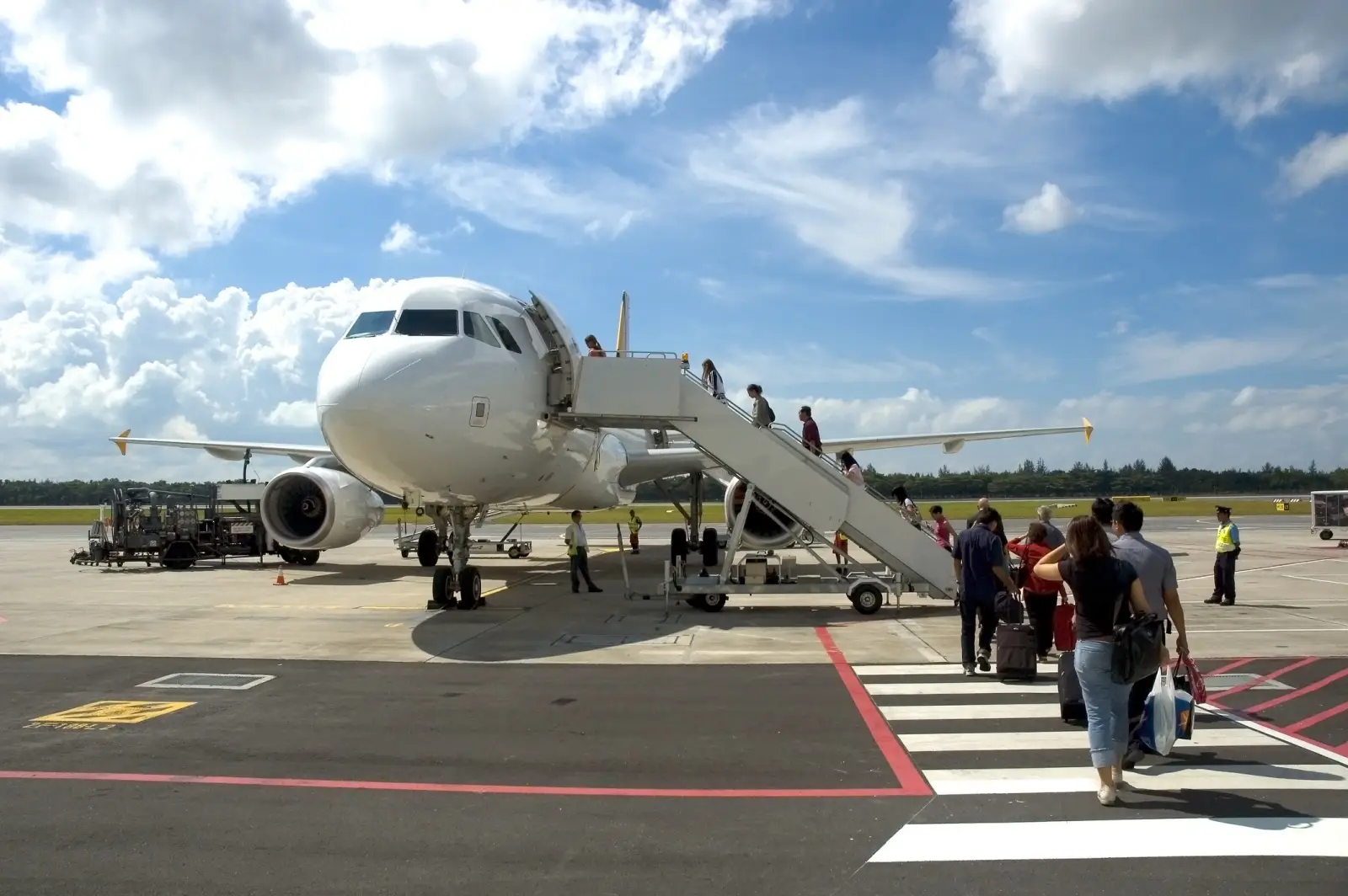The busiest airports in Spain saw major growth this spring, as Aena reports a record-breaking March 2025 across passenger traffic, flight operations, and cargo movement. According to the latest monthly statistics from Aena, Spain’s leading airport operator, more than 28.7 million passengers passed through its global network in March—an increase of 4.3% compared to the same month last year.
Among these, the airports of Adolfo Suárez Madrid-Barajas, Josep Tarradellas Barcelona-El Prat, and Málaga-Costa del Sol ranked as the top performers. Madrid handled over 5.5 million passengers (+3%), while Barcelona welcomed more than 4.3 million (+1.8%). Málaga saw the biggest year-on-year growth among the three, with nearly 1.9 million travelers—a strong 8.3% rise.
Aena Group airports
Aena Group airports (comprising 46 airports and two heliports in Spain, London Luton Airport, and 17 airports in Brazil) closed the third month of 2025 with 28,775,355 passengers, 4.3% more than the same month in 2024; they handled 249,502 aircraft movements, 3.9% more than in 2024; and transported 126,889 tons of cargo, 7.6% more than last year. It is worth remembering that Easter took place in March 2024, unlike this year, which falls in April.
In cumulative terms, 78,312,273 passengers passed through Aena Group airports in the first quarter of 2025 (4.9% more than in 2024); 695,281 aircraft movements were recorded (+4%); and 346,728 tons of cargo were transported, 6.1% more than in the same period in 2024.
Aena airports in Spain
Aena’s network of airports in Spain closed March with 23,820,386 passengers, 4.2% more than in the same month in 2024; they handled 202,270 aircraft movements, 5.7% more than in 2024; and transported 114,078 tons of cargo, 7.6% more than last year.
Adolfo Suárez Madrid-Barajas Airport recorded the highest number of passengers in March with 5,503,333, representing a 3% increase compared to the same month last year. It was followed by Josep Tarradellas Barcelona-El Prat airports, with 4,356,270 (+1.8% compared to 2024); Málaga-Costa del Sol, with 1,897,983 (+8.3%); Palma de Mallorca, with 1,551,262 (+1.5%); Gran Canaria, with 1,489,837 (+0.7%); Alicante-Elche Miguel Hernández, with 1,475,739 (+16.4%); and Tenerife Sur, with 1,378,759 passengers, which is 2.4% more than in March 2024.
Last month, absolute passenger records were broken at six airports in the network: Gran Canaria, Tenerife Sur, Seville, César Manrique-Lanzarote, Fuerteventura, and La Palma. Likewise, a record number of passengers has been reached for the month of March across the Aena network and at 16 airports: Adolfo Suárez Madrid-Barajas, Josep Tarradellas Barcelona-El Prat, Palma de Mallorca, Málaga-Costa del Sol, Alicante-Elche Miguel Hernández, Gran Canaria, Tenerife Sur, Valencia, Seville, César Manrique-Lanzarote, Fuerteventura, Bilbao, Tenerife Norte-Ciudad de La Laguna, La Palma, Asturias and A Coruña.
In terms of operations, the airport with the most movements in March was Adolfo Suárez Madrid-Barajas, with a total of 35,544 (+3.7% compared to 2024), followed by Josep Tarradellas Barcelona-El Prat, with 28,411 flights (+5.2%); Gran Canaria, with 13,505 (+2.1%); Málaga-Costa del Sol, with 13,489 (+11.3%); Palma de Mallorca, with 12,627 (+1.3%); Alicante-Elche Miguel Hernández, with 9,396 (+19.1%); and Tenerife Sur, with 9,157 landings and takeoffs (+6.3%).
During the third month of 2025, five airports recorded their busiest month to date: Gran Canaria, Tenerife Sur, César Manrique-Lanzarote, Fuerteventura, and Tenerife Norte-Ciudad de La Laguna. In addition, March was the month with the most overall operations across the Aena network and 13 infrastructures: Málaga-Costa del Sol, Palma de Mallorca, Gran Canaria, Alicante-Elche Miguel Hernández, Tenerife Sur, Seville, César Manrique-Lanzarote, Tenerife Norte-Ciudad de La Laguna, La Palma, Fuerteventura, Logroño, Son Bonet, and Córdoba.
Madrid and Barcelona Dominate Cargo Movement
Adolfo Suárez Madrid-Barajas handled the most cargo in March, with 70,919 tonnes—an 8.8% year-on-year increase and the highest commercial cargo traffic for any March in the airport’s history. Barcelona followed with 16,359 tonnes (+6.6%), also setting a new March cargo record.
Other key cargo hubs included Zaragoza with 14,225 tonnes (+6.2%) and Vitoria with 5,974 tonnes (+2.2%).
Aena Brazil Airports
Aena Brasil’s 17 airports reached 3,633,448 passengers last March, 4.5% more than in the same month of 2024. There were 36,880 aircraft movements, a 5.2% decrease compared to the same month in 2024, and 10,379 tons of cargo were transported, a 13.4% increase compared to the same month of the previous year.
AENA Brasil’s group of six airports (1) closed March with 1,316,829 passengers (+7%). Recife Airport reached 782,905 passengers (+4.2%). 12,306 flights were operated (-0.9%), of which Recife handled 7,141 (-1.9%). And 5,424 tons of cargo were transported (+7.1%), of which 4,495 tons corresponded to the Recife airport (+7.4%).
The BOAB group of eleven airports (2) registered 2,316,619 passengers in March (+3.1% compared to the same month in 2024). Among them, Congonhas Airport stands out with 1,960,556 passengers (+2.2%). 24,574 flights were operated (-7.2%), of which 17,710 were reached at the airport in the capital of São Paulo (-10.9%). And 4,955 tons of cargo were transported (+21.2%). At Congonhas Airport in São Paulo, 4,332 tons were managed, 37.5% more than in the same month of the previous year.
As of March 2025, 11,075,212 travelers (up 5.3%) have passed through Aena’s airports in Brazil; 110,929 aircraft movements were recorded (down 4.3%); and 30,712 tons of cargo were transported, 15.9% more than in the same period in 2024.
London Luton Airport
Throughout March, 1,321,521 passengers (3) passed through London Luton Airport, 6.3% more than in the same month of 2024. There were 10,352 aircraft movements (+4.2%) and 2,496 tonnes of cargo (4) transported, 11.9% less than in 2024.
During the first quarter of 2025, 3,621,823 passengers (3) were registered (+7.3%), 28,827 aircraft movements were managed (+3.7%) and 7,124 tonnes of cargo (4) were transported (-3.2%).













